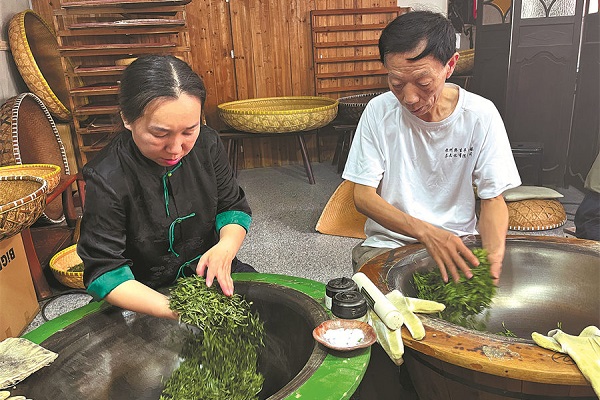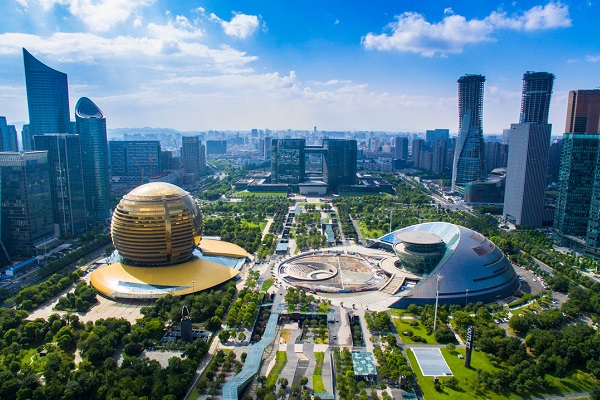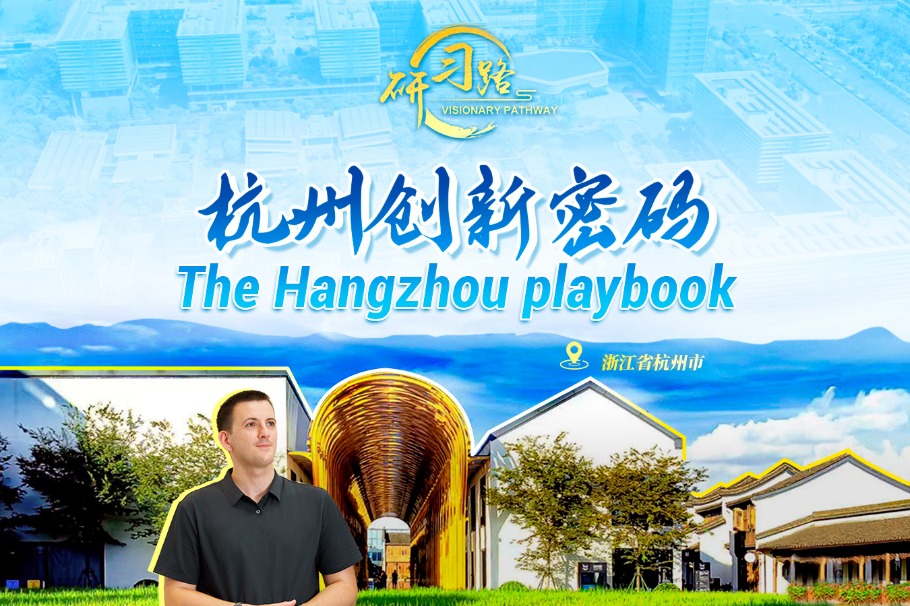Master the art down to a tea

Fan Shenghua, 64, instructs a woman at his studio in Tongwu village, Hangzhou, Zhejiang province. YANG YANG/CHINA DAILY and LI ZHONG/FOR CHINA DAILY
Hand stirrers leave machines far behind when it comes to guaranteeing good taste, Yang Yang reports in Hangzhou.
About 1 pm on an early April Friday, at a studio in Tongwu village, one of the planting regions of Longjing (Dragon Well) tea in Hangzhou, East China's Zhejiang province, nine men and a woman were sitting before a shiny steel wok, each with one of their bare hands rhythmically stirring fresh tea leaves that were picked earlier that morning.
The refreshing aroma wafted from the blistering steel woks alongside the tumbling tea leaves, permeating every corner of the space. The weather was unusually hot. All the roasters wore T-shirts. Although two electric fans were running, trying valiantly to cool the air, their clothes were soaked in sweat.
Fan Shenghua, 64-year-old inheritor of the West Lake Dragon Well Tea Picking and Processing Techniques, a national-level intangible cultural heritage item, was instructing the woman on his right while his left hand continued stirring the tea leaves in his wok.
Soon, the woman put a white glove on, because the searing steel wok had branded her right palm with a peanut-sized blister.
"The temperature on the bottom of the wok is usually maintained between 140 and 200 C, so tea roasters, especially a starter like her, must be careful," Fan says.
He started learning tea roasting at 13. His hands are testament to this.
His fingers have large knuckles, and his palms are thick, covered with calluses, almost a badge of honor after five decades of continuous tea roasting with bare hands.
"Authentic West Lake Longjing tea consists of two essential elements: the Longjing tea cultivar and the traditional manual stir-frying techniques. If the leaves are machine-processed, they cannot be called West Lake Longjing tea," he emphasizes.
Hand-roasted tea has a richer, more lasting aroma and a more mellow taste compared to machine-roasted tea, he says.
"It's because tea is 'alive'. Roasters can use different hand movements and temperature to stir-fry tea leaves in different states, which is what unified machine modes cannot achieve," he says.
In March 2020, when Fan was roasting tea at a booth in Xixi Wetland, he had an encounter with President Xi Jinping, who was visiting there on an inspection tour.
"The president scooped up a handful of tea and took a sniff. He humorously remarked that tea fried with just two palms was a feat that modern technology cannot achieve," he recalls.
Encouraged by Xi's words, Fan decided to promote the picking and processing techniques of West Lake Longjing tea via social media. He organized a team to make short videos to showcase how to pick tea leaves and stir-fry them with hands.
In his livestreaming channel, people from around the country watch the process and comment that they want to learn the techniques.
Everyday etiquette
In 2022, China's traditional tea-processing techniques and associated social practices were added to UNESCO's Representative List of the Intangible Cultural Heritage of Humanity.
Since around the 3rd century, tea has been drunk in China, initially among the upper class as an elegant spiritual enjoyment and art, and later becoming popular in the Ming Dynasty (1368-1644) as Emperor Zhu Yuanzhang reformed the method to make tea.
The Dragon Well is said to have been discovered during the Three Kingdoms period (220-280), known as one of the three famous springs in the West Lake areas.
During the Tang Dynasty (618-907), tea cultivation around the West Lake in Hangzhou was mainly concentrated in the vicinity of Lingyin Temple and Tianzhu temples. At that time, monks in the temples cultivated tea on the nearby mountains for self-consumption and treating guests. Gradually, the tea ceremony transitioned from Buddhist rituals to everyday etiquette in the secular society.
In the Song Dynasty (960-1279), Lingyin Temple and Tianzhu temples remained the main tea-producing areas around the West Lake. At that time, several varieties of tea produced in the areas were widely praised, including the Baiyun tea from Shangtianzhu Baiyun Peak, a variety favored by Master Biancai, who served as the abbot at Shangtianzhu Temple.
At nearly 70 years old, Biancai retired to Dragon Well, bringing the Baiyun tea from Shangtianzhu Temple with him. Together with other monks and disciples, he planted tea bushes at the foot of Shifeng Mountain to meet the needs of the temple. The tea planted by Biancai was the precursor of Longjing tea, marking the beginning of a legendary tea story.
During the Yuan Dynasty (1271-1368), tea produced in the Dragon Well area began to appear in poetry. The line, "Drinking the tea made by boiling the golden buds ... one can hardly bear to rinse the mouth after swallowing three times", vividly depicts the lingering taste of the tea in poet Yu Ji's mouth.
In the Ming Dynasty, Longjing tea gradually became a commodity, whose fame was further expanded in the Qing Dynasty (1644-1911).
According to Fan, West Lake Longjing tea has four unique characteristics: sweet taste, beautiful appearance, green color and a rich fragrance reminiscent of orchids.
Fan and his team are currently working for 13 to 14 hours until 2 am every day to make sure that all the fresh tea leaves picked during the day complete the roasting process.
The period between the solar terms Clear and Bright (qing ming), falling usually on April 4 or 5, and Grain Rain (gu yu), 15 days later, is the busiest time of the year for tea production.
Traditionally, in Jiangnan — the region along the southern bank of the lower reaches of the Yangtze River — after Grain Rain, tea production reduces due to the onset of rainy season and declining leaf quality as a result of accelerated growth. Only quality leaves can yield masterfully stir-fried tea, Fan says.
Longjing tea was historically classified by the tenderness grade of leaves: single bud, one bud with one leaf and one bud with two leaves.
Now, West Lake Longjing tea is produced only in spring, and it is picked according to the standard of one bud with one leaf or one bud with two leaves.
The best tea is made from the newly sprouted leaves measuring between 1.2 and 1.5 centimeters. Gradually the leaves will grow to as long as 3.5 cm and their flavor profile will decline accordingly.
Tea roasters' skill plays another crucial role in deciding tea's quality.
The roasting of standard Longjing tea involves nine meticulous steps, including spreading, primary wok-frying, shaping, rehydrating, final wok-frying, sifting and so on. Particularly during the wokfrying process, ancestral tea masters had developed a distinctive technical sequence known as the "10 essential hand movements" of West Lake Longjing tea processing, such as grasping, shaking, pushing, smoothening, pressing and so on.
Fan says that these steps can be carried out sequentially or simultaneously, following the key principle — "the tea stays in the pot, and the hand stays with the tea".
The taste of tea is closely related to the rolling and kneading of the hand movements.
To properly roll and knead the tea leaves, one must have a good grasp of the pressure applied by the hands. If too much pressure is exerted, the tea stems and leaves may break, affecting the appearance. If too little pressure is applied, the tea leaves may not release enough moisture, resulting in a bitter and astringent taste, he says.
In the end, tea quality depends on each master's unique sensory calibration of temperature, individualized hand techniques and meticulous observation.
"This craft requires intuitive mastery. Every practitioner's experience remains fundamentally nonreplicable," he says.
Passing on the craft
After five decades of practice, Fan's tea roasting has become a performing art. In his hand, the tea leaves obediently turn and fall neatly and evenly into the wok, as if they are being tended to with great care, allowing the tea to release its best flavor and aroma.
"It's just like playing tai chi," he says, when his left hand deftly moves the tea leaves in the wok, swirling them to form circles.
In the 2022 West Lake Longjing spring tea presale auction, the half-kilogram batch of tea manually roasted by Fan was sold at the price of nearly 59,800 yuan ($8,200).
As more people are using machines to roast tea, Fan has long been worried about the quality of West Lake Longjing tea, as well as the passing on of the techniques.
"It takes years for one to really master the craft," he says.
Now, in addition to the six apprentices in the studio, he also teaches at Hangzhou Tourism Vocational School and Hangzhou West Lake Vocational High School, with over 100 students.
"My father is willing to share his expertise with all people who want to learn, even his peers. He does not keep the techniques to himself; instead, he wants people to know that they are not complicated. It's just about constantly improving to achieve excellence," says Fan's son, 32-year-old Fan Xuesong.
Fan Xuesong graduated from university majoring in hotel management in 2016. Now, apart from learning tea roasting, he is also running the family's tea business, which ranges from the popularization of tea culture, training of tea-roasting techniques, to sales and study tours.
But Fan Shenghua still focuses only on the techniques. Asked whether he is proud of producing such great tea that has been widely recognized in the world, he plainly says that "it's just because the tea is of good quality".
"Only if we produce high-quality tea, can the fame of West Lake Longjing tea be spread to farther places," he says, while stirring the green leaves in the wok.
-
Visionary Pathway - Hangzhou Playbook
July 15, 2025



